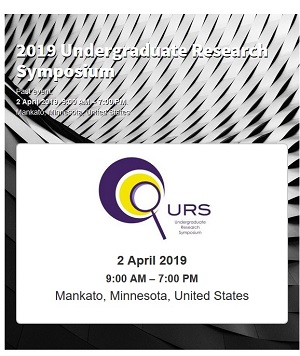Aquaponics Demonstration Project Using MN Hybrid Bluegills (Fish)
Location
CSU Ballroom
Start Date
2-4-2019 10:00 AM
End Date
2-4-2019 11:30 AM
Student's Major
Biological Sciences
Student's College
Science, Engineering and Technology
Mentor's Name
Beth Proctor
Mentor's Department
Biological Sciences
Mentor's College
Science, Engineering and Technology
Description
It is increasingly difficult to feed the world's ever increasing human population using only traditional farming methods. Aquaponics is a relatively new technology that utilizes fish and plants in an almost self-sustaining system. Water containing the fish wastes are used to fertilize the plants and then the water is recycled back to the fish. The fish we chose to use in this study are Minnesota native Hybrid Bluegill. They are used to stock ponds. These fish grow fast and accept man made feed easily. The goal of this research is to create and maintain an aquaponics system to harvest both fish and food crops such as lettuce, spinach and herbs. Endpoints will include growth/harvest of organic plants (lettuce, spinach, basil) and fish. Once this system is running smoothly, we will expand to growing organic specialty greens such as Arugula, Red Mustard, Tatsoi and Kale that can be harvested in 3-6 weeks cycles. This system has the potential to provide more fresh food (plant and animal protein), an alternative or additional source of revenue for farmers large and small since specialty organic foods command higher prices. This pilot system should be able to be scaled up (size of tanks, number of fish, energy /light/heat requirements/cost and profit from organic specialty plants) and adaptable to existing greenhouse and underground operations in Minnesota.
Aquaponics Demonstration Project Using MN Hybrid Bluegills (Fish)
CSU Ballroom
It is increasingly difficult to feed the world's ever increasing human population using only traditional farming methods. Aquaponics is a relatively new technology that utilizes fish and plants in an almost self-sustaining system. Water containing the fish wastes are used to fertilize the plants and then the water is recycled back to the fish. The fish we chose to use in this study are Minnesota native Hybrid Bluegill. They are used to stock ponds. These fish grow fast and accept man made feed easily. The goal of this research is to create and maintain an aquaponics system to harvest both fish and food crops such as lettuce, spinach and herbs. Endpoints will include growth/harvest of organic plants (lettuce, spinach, basil) and fish. Once this system is running smoothly, we will expand to growing organic specialty greens such as Arugula, Red Mustard, Tatsoi and Kale that can be harvested in 3-6 weeks cycles. This system has the potential to provide more fresh food (plant and animal protein), an alternative or additional source of revenue for farmers large and small since specialty organic foods command higher prices. This pilot system should be able to be scaled up (size of tanks, number of fish, energy /light/heat requirements/cost and profit from organic specialty plants) and adaptable to existing greenhouse and underground operations in Minnesota.
Recommended Citation
Garcia, Sara and Caitlin Murphy. "Aquaponics Demonstration Project Using MN Hybrid Bluegills (Fish)." Undergraduate Research Symposium, Mankato, MN, April 2, 2019.
https://cornerstone.lib.mnsu.edu/urs/2019/poster-session-A/29



